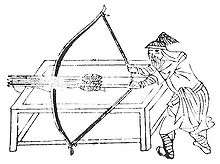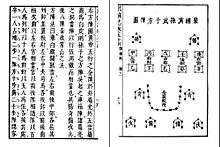Wubei Zhi
The Wubei Zhi (Chinese: 武備志; Treatise on Armament Technology or Records of Armaments and Military Provisions), also commonly known by its Japanese translated name Bubishi,[1][2][3] is the most comprehensive military book in Chinese history. It was compiled in 1621 by Mao Yuanyi (茅元儀 Máo Yuányí; 1594–1640?), an officer of waterborne troops in the Ming Dynasty. The Wubei Zhi contains 240 volumes, 10405 pages, and more than 200,000 Chinese characters, which makes it the longest book in Chinese history regarding military affairs.[4]
| Wubei Zhi | |||||||
|---|---|---|---|---|---|---|---|
| Traditional Chinese | 武備志 | ||||||
| Simplified Chinese | 武备志 | ||||||
| Literal meaning | military preparation records | ||||||
| |||||||


Structure
Wubei Zhi consists of five sections, "Bing Jue Ping", "Zhan Lue Kao", "Zhen Lian Zhi", "Jun Zi Sheng", and "Zhan Du Zai".
- "Bing Jue Ping" (Commentary on Military Formulae)
Containing 18 chapters, this section includes military theories such as those of Sun Tzu, some dating back to the last years of Eastern Zhou Dynasty, more than 1,800 years before the editor.
- "Zhan Lue Kao" (Consideration of Tactics)
This section comprises 31 chapters, and describes more than 600 specific examples of battle that took place between the Eastern Zhou Dynasty and the Yuan Dynasty. Among those are Battle of Maling, Battle of Red Cliffs, which is a classic example of defeating overpowering enemy.
- "Zhen Lian Zhi" (Record of Formations and Training)
This section of the book, of 41 chapters, introduces different ways of training troops including infantry, cavalry and chariots, as well as individual martial arts training with different weapons such as the spear and Dao.
- "Jun Zi Sheng" (Summary of Logistics)
This section is divided into 55 categories, covering a variety of contents related to wartime logistics, such as marching, encamping, troops arraying, transmitting orders, attacking and defending cities, and provision of food, weapons, health care and transportation, to name but a few.
- "Zhan Du Zai"
In this section, with 96 chapters, the author introduces aspects of weather and geographic features that are related to war fighting, as well as traditional Chinese methods of divination, formation, and finally marine navigation. Included into this section is the so-called "Mao Kun map", the unique surviving map representing the Pacific and Indian Ocean shipping routes used by the fleets of Zheng He.[5]
Impact
Being known as "a military encyclopedia in ancient China", Wubei Zhi is one of the most influential works in Chinese history on warfare. It is a rare source of some compass maps and designs and some weapons has contributed enormously to corresponding areas, and it also gives an account of ancient Chinese military theories and Chinese militarists' thoughts.[6]
See also
External links
Notes
- Zhongyi, Tong; Cartmell, Tim (2005-01-01). The Method of Chinese Wrestling. North Atlantic Books. ISBN 9781556436093.
- weissberg, michael (2011-07-31). The Firearm as a Martial Arts Weapon. Lulu.com. ISBN 9780983486657.
- McCarthy, Patrick (1995-01-01). Bible of Karate, The; Bubishi. Tuttle Publishing. ISBN 9780804820158.
- Wubei Zhi. (n.d.). Retrieved April 24, 2008, from Baidu Baike. (in Chinese)
- Ma & Mills 1970, pp. 246 sq
- Wubei Zhi. (n.d.). Retrieved February 24, 2009, from China001.com website. (in Chinese)
References
| Wikimedia Commons has media related to Wubei Zhi. |
- Ma, Huan; Mills, J.V.G. (John Vivian Gottlieb) (1970), "Ying-yai Sheng-lan", The Overall Survey of the Ocean's Shores 1433, London: Hakluyt Society (reprinted by the White Lotus Press, 1997, ISBN 974-8496-78-3; restricted online copy at Google Books)